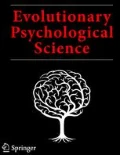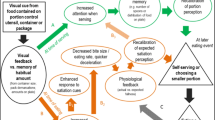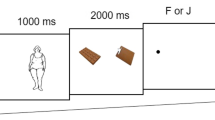Abstract
Previous research has suggested that women’s food intake is influenced by increases in progesterone, most notably during the post-ovulatory period. Additionally, body mass index and high-density foods play a contributing role in the amount of attention given to food. Although research has primarily focused on women’s self-reported ratings across the menstrual cycle, whether women’s attention to food is influenced by progesterone levels, menstrual status, and BMI has been unexplored. The current study investigated women’s visual attention to high and low-caloric food items. Across two lab visits, women’s progesterone levels were tracked while they completed an eye-tracking task. The results demonstrated that high-caloric foods were viewed longer irrespective of BMI, and there was tentative support for women’s progesterone influencing their first fixation durations to high-caloric foods. Overall, the findings suggest that high caloric foods were visually salient, which may be indicative of how humans allocate attention to food high in energy density, and it suggests that women’s early attentional processes are partly influenced by sex hormones (i.e., progesterone).


Similar content being viewed by others
Data Availability
Data is available upon authors’ request.
References
Al-Shawaf, L. (2016). The evolutionary psychology of hunger. Appetite, 105, 591–595.
Asarian, L., & Geary, N. (2006). Modulation of appetite by gonadal steroid hormones. Phil Trans R Soc B, 361, 1251–1263.
Babesque, J. C., & Marlowe, F. W. (2009). Sex differences in food preferences of Hazda hunter-gatherers. Evolutionary Psychology, 7, 601–616.
Birch, L. L. (1999). Development of food preferences. Annu. Rev. Natr., 19, 41–62.
Blake, K. R., Dixson, B. J. W., O’Dean, S. M., & Denson, T. F. (2016). Standardized protocols for characterizing women’s fertility: a data-driven approach. Hormones and Behavior, 81, 74–83.
Buffenstein, R., Poppitt, S. D., McDevitt, R. M., & Prentice, A. M. (1995). Food intake and the menstrual cycle: a retrospective analysis, with implications for appetite research. Physiology and Behavior, 58(6), 1067–1077.
Butera, P. C. (2010). Estradiol and the control of food intake. Physiology and Behavior, 99(2), 175–80.
Castelanos, E. H., Charboneau, E., Dietrich, M. S., Park, S., Bradley, B. P., Mogg, K., & Cowan, R. L. (2009). Obese adults have visual attention bias for food cue images: evidence for altered reward system function. International Journal of Obesity, 33, 1063–1073.
Conklin, K., Pellicer-Sanchez, A., & Carrol, G. (2018). Eye-tracking: a guide for applied linguistic research. New York, NY: Cambridge University Press.
Crane, M., Bohn-Goldbaum, E., Grunseit, A., & Bauman, A. (2020). Using natural experiments to improve public evidence: a review of context and utility for obesity prevention. Health Research Policy and Systems, 18(48), 1–13.
Cross, G. B., Marley, J., Miles, H., & Wilson, K. (2001). Changes in nutrient intake during the menstrual cycle of overweight women with premenstrual syndrome. British Journal of Nutrition, 85, 475–482.
Doolan, K. J., Breslin, G., Hanna, D., Murphy, K., & Gallagher, A. M. (2014). Visual attention to food cues in obesity: an eye-tracking study. Obesity, 22(12), 2503–2507.
Dye, L., & Blundell, J. E. (1997). Menstrual cycle and appetite control: implications for weight regulation. Human Reproduction, 12(6), 1142–1151.
Edler, C., Lipson, S. F., & Keel, P. K. (2007). Ovarian hormones and binge eating in bulimia nervosa. Psychological Medicine, 37, 131–141.
Fessler, D. M. T. (2003). No time to eat: an adaptationist account of periovulatory behavioral changes. The Quarterly Review of Biology, 78(1), 3–21.
Gangestad, S. W., Haselton, M. G., Welling, L. M., Gildersleeve, K., Pillsworth, E. G., Burriss, R. P., et al. (2016). How valid are assessments of conception probability in ovulatory cycle research? Evaluations, recommendations, and theoretical implications. Evolution and Human Behavior, 37, 85–96.
Genne-Bacon, E. A. (2014). Thinking evolutionarily about obesity.Yale Journal of Biology and Medicine, 87, 99–112.
Gildersleeve, K., Haselton, M. G., & Fales, M. R. (2014). Do women’s mate preferences change across the ovulatory cycle? A meta-analytic review, Psychological Bulletin, 140, 1205–1259.
Goetz, C. D., Pillsworth, E. G., Buss, D. M., & Conroy-Beam, D. (2019). Evolutionary mismatch in mating. Frontiers in Psychology: Evolutionary Psychology, 10(2709), 1–15.
Graham, R., Hoover, A., Ceballos, N. A., & Komogortsev, O. (2011). Body mass index moderates gaze orienting biases and pupil diameter to high and low calorie food images. Appetite, 56, 577–586.
Herman, C. P., & Polivy, J. (2010). Sex and gender differences in eating behavior. In: Chrisler J., McCreary D. (eds) Handbook of Gender Research in Psychology. Springer, New York, NY.
Hirschberg, A. L. (2012). Sex hormones, appetite and eating behavior in women. Maturitas, 71, 248–256.
Hill, S. E., Rodeheffer, C. D., DelPriore, D. J., & Butterfield, M. E. (2013). Ecological contingencies in women’s calorie regulation psychology: a life history approach. Journal of Experimental Social Psychology, 49, 888–897.
Hsu, L. K. G. (1989). The gender gap in eating disorders: Why are the eating disorders more common among women? Clinical Psychology Review, 9, 393–407.
Karastergiou, K., Smith, S. R., Greenberg, A. S., & Fried, S. K. (2012). Sex differences in human adipose tissues-the biology of pear shape. Biol Sex Differ, 3(13), 1–12.
King, B. M. (2013). The modern obesity epidemic, ancestral hunter-gatherers, and the sensory/reward control of food intake. American Psychologist, 68(2), 88–96.
Kleinke, C. L. (1986). Gaze and eye contact: a research review. Psychological Bulletin, 100(1), 78–100.
Klump, K. L., Keel, P. K., Culbert, K. M., & Edler, C. (2008). Ovarian hormones and binge eating: exploring associations in community samples. Psychological Medicine, 38(12), 1749–1757.
Krupp, D. B. (2008). Through evolution’s eyes: Extracting mate preferences by linking visual attention to adaptive design. Archives of Sexual Behavior, 37, 57–63.
Laran, J., & Salerno, A. (2012). Life-history strategy, food choice, and calorie consumption. Psychological Science, 24(2), 167–173.
Li, N. P., van Vugt, M., & Colarelli, S. M. (2018). The evolutionary mismatch hypothesis: implications for psychological science. Current Directions in Psychological Science, 27(1), 38–44.
Lopez, L. M., Edelman, A., Chen, M., Otterness, C., Trussell, J., & Helmerhost, F. M. (2007). Progestin-only contraceptives: effects on weight. The Cochran database of systematic reviews, 7(7), CD008815, 1–47.
Manippa, V., van der Laan, L., Brancucci, A., & Smeets, P. A. M. (2019). Health and priming and food choice: an eye tracking study. Food Quality and Preferences, 72, 116–125.
Neel, J. V. (1962). Diabetes mellitus: A “thrifty” genotype rendered detrimental by progress? American Journal of Human Genetics, 14, 353–362.
Nijs, I. M. T., Muris, P., Euser, A. S., & Franken, I. H. A. (2010). Differences in attention to food and food intake between overweight/obese and normal-weight females under conditions of hunger and satiety. Appetite, 54, 243–254.
Power, M. L. (2012). The human obesity epidemic, the mismatch paradigm, and our modern “captive” environment. American Journal of Human Biology, 24, 116–122.
Rantala, M. J., Luoto, S., Krama, T., & Krams, I. (2020). Eating disorders: an evolutionary psychoneuroimmunological approach. Frontiers in Psychology: Evolutionary Psychology, 10, 1–21.
Richard, J. E., Lopez-Ferreras, L., & Anderberg, R. H. (2017). & Olandersson. Psychonueroendocrinology, 78, 193–202.
Rozin, P., & Schull, J. (1988). The adaptive-evolutionary point of view in experimental psychology. In R. C. Atkinson, R. J. Herrnstein, G. Lindzey, & R. D. Luce (Eds.) Stevens’ handbook of experimental psychology: Vol. 1. Perception and motivation (2nd., pp. 503–546). New York: Wiley.
Saad, G., & Stenstrom, E. (2012). Calories, beauty, and ovulation: the effects of the menstrual cycle on food and appearance-related consumption. Journal of Consumer Psychology, 22, 102–113.
Schotter, E. R., Berry, R. W., McKenzie, C. R., & Rayner, K. (2010). Gaze bias: selective encoding and liking effects. Visual Cognition, 18(8), 1113–1132.
Sharan, P., & Sundar, A. S. (2015). Eating disorders in women. Indian Journal of Psychiatry, 57(2), 286–295.
Strassman, B. I. (1996). The evolution of endometrial cycles and menstruation. Quarterly Review of Biology, 71, 181–220.
Taylor, H. A., Jr., Coady, S. A., Levy, D., Walker, E. R., Vasan, R. S., Liu, J., et al. (2010). Relationships of BMI to cardiovascular risk factors differ by ethnicity. Obesity, 18(8), 1638–1645.
Tooby, J., & Cosmides, L. (1990). The past explains the present. Emotional adaptations and the structure of ancestral environments. Ethology and Sociobiology, 11, 375–424.
Wade, G. N., & Schneider, J. E. (1992). Metabolic fuels and reproduction in female mammals. Neuroscience & Biobehavioral Reviews, 16(2), 235–72.
Wang, E., Cakmak, U. O., & Peng, M. (2018). Eating with eyes: comparing eye movements and food choices between overweight and lean individuals in a real-life buffet setting. Appetite, 125, 152–159.
Webb, P. (1986). 24-hour energy expenditure and the menstrual cycle. American Journal of Clinical Nutrition, 44, 614–619.
Werthmann, J., Roefs, A., Nederkoorn, C., Mogg, K., & Bradley, B. P. (2011). Can(not) take my eyes off it: attention bias of food in overweight participants. Health Psychology, 30(5), 561–569.
Werthmann, J., Jansen, A., Vreugdenhil, A. C. E., Nederkoorn, C., Schyns, G., & Roefs, A. (2015). Food through the child’s eyes: an eye-tracking study on attentional bias for food in healthy-weight children and children with obesity. Health Psychology, 34(12), 1123–1132.
Westhoff, C. L., Heartwell, S., Edwards, S., Zieman, M., Stuart, G., Cwiak, C., Davis, A., Robilotto, T., Cushman, L., & Kalmuss, D. (2007). Oral contraceptive discontinuation: Do side effects matter? American Journal of Obstetrics & Gynecology, 196, 412e.1 - 412e.7.
Wurtman, J. J., Brzezinski, A., Wurtman, R. J., & Laferrere, B. (1989). Effect of nutrient intake on premenstrual depression. American Journal of Obstetrics and Gynecology, 161, 1228–1234.
Yen, J. Y., Lin, H. C., Lin, P. C., Liu, T. L., Long, C. Y., & Ko, C. H. (2019). Early-and late-luteal-phase estrogen and progesterone levels of women with premenstrual dysphoric disorder. International Journal of Environmental Research and Public Health., 16, 1–11.
Ziomkiewicz, A., Ellison, P. T., Lipson, S. F., Thune, I., & Jasienska, G. (2008). Body fat, energy balance and estradiol levels: a study based on hormonal profiles from complete menstrual cycles. HumanReprodroduction, 23, 2555–2563.
Author information
Authors and Affiliations
Corresponding author
Ethics declarations
Conflict of Interest
The authors declare that they have no conflict of interest.
Ethics Approval
The study was approved by the Institutional Review Board at Oklahoma State University.
Consent to Participate
All participants provided written consent to participate.
Consent to Publish
All authors consent to publish.
Additional information
Publisher’s Note
Springer Nature remains neutral with regard to jurisdictional claims in published maps and institutional affiliations.
Rights and permissions
About this article
Cite this article
Garza, R., Clauss, N. & Byrd-Craven, J. Do BMI and Sex Hormones Influence Visual Attention to Food Stimuli in Women? Tracking Eye Movements Across the Menstrual Cycle. Evolutionary Psychological Science 7, 304–314 (2021). https://doi.org/10.1007/s40806-020-00273-7
Received:
Revised:
Accepted:
Published:
Issue Date:
DOI: https://doi.org/10.1007/s40806-020-00273-7




